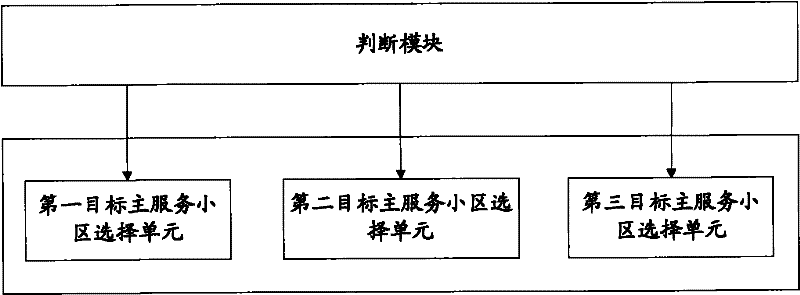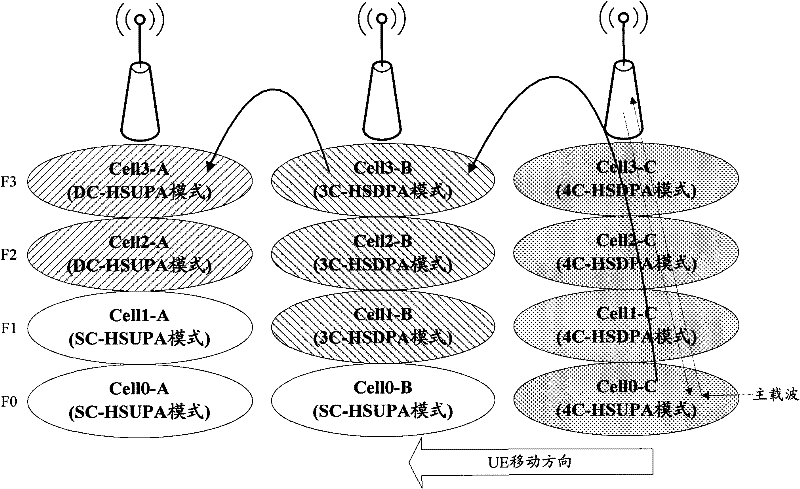Main carrier optimal selection method and device in multi-carrier hybrid configuration mode
A technology of configuration mode and optimization selection, applied in electrical components, wireless communication and other directions, can solve the problem of not being able to select the optimal target primary serving cell, and the RRM handover algorithm does not consider the multi-carrier hybrid working mode.
- Summary
- Abstract
- Description
- Claims
- Application Information
AI Technical Summary
Problems solved by technology
Method used
Image
Examples
Embodiment 1
[0067] Such as image 3 As shown, the network is configured with 4C-HSDPA mode in the areas served by Cell0-C, Cell1-C, Cell2-C, and Cell3-C; in the areas served by Cell1-B, Cell2-B, and Cell3-B, 3C is configured -HSDPA mode; in the area served by Cell2-A and Cell3-A, DC-HSUPA mode is configured; in the area served by Cell0-B, Cell0-A, and Cell1-A, SC-HSUPA mode is configured. During a UE call with UE-MCmax=4, the UE is initially in the area of NW-MCmax=4, and selects F0 as its main carrier plane, so Cell0-C is its main serving cell, Cell1-C, Cell2 -C, Cell3-C is the secondary serving cell, UE-MCop=4, and uplink data transmission occurs on carrier planes F0 and F1. Subsequently, the UE moves to the left and is about to enter the B-series cell area. In the B series cell area, Cell0-B(NW-MCmax=1), Cell1-B(NW-MCmax=3), Cell2-B(NW-MCmax=3), Cell3-B(NW-MCmax=3) All are the candidate target main serving cells that meet the conditions, according to the algorithm of the present i...
Embodiment 2
[0070] Such as Figure 4 As shown, the network is configured with 4C-HSDPA mode in the areas served by Cell0-C, Cell1-C, Cell2-C, and Cell3-C; in the areas served by Cell0-B, Cell1-B, and Cell2-B, 3C is configured -HSDPA mode; in the area served by Cell2-A and Cell3-A, DC-HSUPA mode is configured; in the area served by Cell3-B, Cell0-A, and Cell1-A, SC-HSUPA mode is configured. During a call with a UE with UE-MCmax=4, the UE is initially in the area of NW-MCmax=2, and selects F3 as its main carrier plane, so Cell3-A is its main serving cell, and Cell2-A is its main carrier plane. In the secondary serving cell, UE-MCop=2, uplink data transmission occurs on carrier planes F2 and F3. Subsequently, the UE moves to the right and is about to enter the B-series cell area. In the B series cell area, Cell0-B(NW-MCmax=3), Cell1-B(NW-MCmax=3), Cell2-B(NW-MCmax=3), Cell3-B(NW-MCmax=1) All are candidate target primary serving cells that meet the conditions. According to the algorithm...
Embodiment 3
[0073] Such as Figure 5As shown, in the C series of cells, only Cell4-C and Cell5-C serve the area, and the DC-HSUPA mode is configured, and the remaining C cells are configured with SC-HSUPA mode; in the B series of cells, Cell4-B, Cell5-B, Cell6-B, and Cell7-B service areas are configured with 4C-HSDPA mode, and DC-HSUPA mode is configured in other B cells; in the A series of cells, Cell0-A, Cell1-A, Cell2-A In the service area, 3C-HSDPA mode is configured, and SC-HSUPA mode is configured in the remaining A cells. During a UE call with UE-MCmax=4, the UE is initially in the area of NW-MCmax=3, and selects F0 as its main carrier plane, so Cell0-A is its main serving cell, Cell1-A, Cell2 - A is its secondary serving cell, UE-MCop=3, and uplink data transmission occurs on carrier planes F0 and F1. Subsequently, the UE moves to the right and is about to enter the B-series cell area. In the B-series cell area, all B cells are candidate target primary serving cells that meet...
PUM
 Login to View More
Login to View More Abstract
Description
Claims
Application Information
 Login to View More
Login to View More - R&D Engineer
- R&D Manager
- IP Professional
- Industry Leading Data Capabilities
- Powerful AI technology
- Patent DNA Extraction
Browse by: Latest US Patents, China's latest patents, Technical Efficacy Thesaurus, Application Domain, Technology Topic, Popular Technical Reports.
© 2024 PatSnap. All rights reserved.Legal|Privacy policy|Modern Slavery Act Transparency Statement|Sitemap|About US| Contact US: help@patsnap.com










